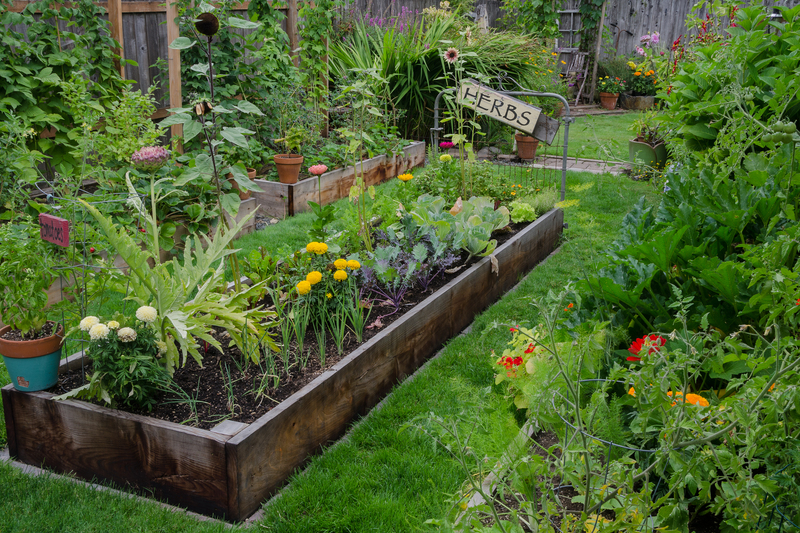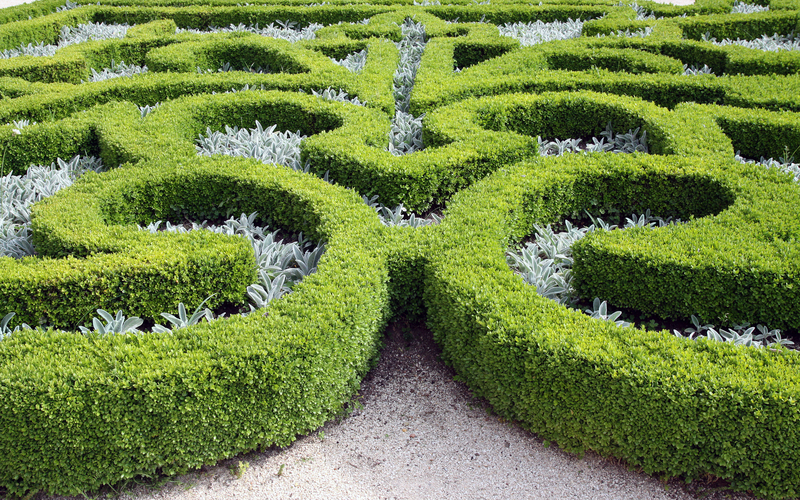The Initial Steps to Restoring an Abandoned Garden
Posted on 25/06/2025
The Initial Steps to Restoring an Abandoned Garden
Restoring an abandoned garden is a rewarding endeavor that not only revitalizes a neglected space but also brings back natural beauty, biodiversity, and a sense of tranquility. Many garden enthusiasts and homeowners often face the overwhelming challenge of reclaiming overgrown or deserted gardens. Whether you have just purchased a property with a neglected landscape or inherited an overgrown backyard, this comprehensive guide will walk you through the initial steps to restore an abandoned garden. From thorough assessment to early rejuvenation, you'll discover expert tips designed to transform a forgotten patch of land into a flourishing haven.

Understanding the Challenges of Garden Restoration
Neglected gardens pose several unique challenges. Over time, unwanted weeds, invasive species, pests, and diseases may take over, while desirable plants struggle in poor soil conditions. Paths, fences, or structures may be decaying, and garden layouts can become nearly indistinguishable. The first phase of any abandoned garden restoration should focus on understanding the current state and setting a clear plan for recovery.
Why Should You Restore an Old or Abandoned Garden?
- Increases Property Value: Well-maintained gardens enhance curb appeal and property value.
- Environmental Benefits: Restoring green spaces increases biodiversity and contributes to a healthier ecosystem.
- Mental and Physical Health: Gardening provides therapeutic benefits, reducing stress and increasing physical activity.
- Personal Satisfaction: Witnessing the rebirth of a neglected garden brings immense pride and accomplishment.
Essential Preparations Before Restoration
Success in restoring a neglected garden starts with thorough preparation. Here are the key initial steps to revive an abandoned garden:
1. Safety First: Protect Yourself
- Wear protective clothing: Sturdy boots, long sleeves, gloves, and eye protection are essential when dealing with unknown hazards.
- Beware of wildlife: Snakes, wasps, or other critters may have taken residence. Stay vigilant.
- Use the right tools: Sharp pruners, spades, and forks will make cleanup safer and easier.
2. Analyze the Site Thoroughly
Survey the entire garden plot to understand what you are working with. Take careful note of:
- Large trees and shrubs - Identify which ones are healthy and worth keeping.
- Sunlight Patterns: Observe which areas receive full sun, partial shade, or deep shade throughout the day.
- Soil condition: Check for compaction, drainage, and signs of disease.
- Existing infrastructure: Note the placement and condition of fences, sheds, paths, irrigation systems, and raised beds.
- Potential hazards: Look for buried debris, glass, or chemicals.
Take photographs and notes to create a record of the starting point and track progress over time.
Step-By-Step Approach to Reviving Your Abandoned Garden
Once you have assessed the landscape, organizing your approach is crucial. The stepwise restoration process ensures you prioritize urgent tasks while setting the foundation for sustained growth and beauty.
Step 1: Clear Debris and Junk
- Remove litter, fallen branches, old furniture, plastic, metal, and any rubbish contaminating the area.
- Separate recyclable and hazardous materials for safe disposal.
- Compost what you can--dead leaves, twigs, and non-diseased organic matter can be valuable later.
Step 2: Tame Overgrown Areas
- Cut down tall grass and weeds with a strimmer, scythe, or power mower on the highest setting.
- For dense weed patches, use a hoe or spade, taking care not to disturb roots of desirable plants.
- Work in small, manageable sections rather than trying to clear the entire garden at once.
- Use a tarp to transport green waste to a compost area or collection site.
Step 3: Identify Existing Plant Life
- Learn to recognize valuable specimens among weeds--mature trees, shrubs, bulbs, and perennials could be hiding.
- Tag plants worth saving with ribbon or markers to avoid accidental removal.
- Consult local experts or join gardening forums for help with unidentified plants.
Step 4: Evaluate and Improve the Soil
- Test soil pH and fertility by using a testing kit available at garden centers or through local extension services.
- Address compaction: Gently aerate with a garden fork or mechanical aerator if the soil is dense.
- Add organic matter: Mix in compost, well-rotted manure, or leaf mold to boost soil structure and nutrition.
- If present, remove buried debris or stones that could hinder planting and root growth.
Step 5: Establish Boundaries and Visualize Design
- Reclaim or repair physical boundaries: Fix or replace fences, edging, and garden paths to delineate your garden spaces.
- Sketch a rough plan: Visualize which areas you want for lawns, flower beds, vegetable plots, or leisure spaces.
- Use stakes, string, or painted lines to outline future beds or pathways.
Expert Tips for Early Garden Restoration Success
- Start small: Focus on one section of the garden at a time to avoid burnout and track progress more easily.
- Document your journey: Take before-and-after photos to celebrate milestones and share with others.
- Don't rush removal: Allow a full season to identify plants as some perennials and bulbs may only appear later in the year.
- Mulch exposed soil: After clearing weeds, cover bare soil with natural mulch to suppress regrowth and conserve moisture.
- Boost soil health gradually: Incorporating organic materials in stages will yield better long-term growth and resilience.
Understanding the Importance of Soil Restoration
One of the most critical aspects in restoring an abandoned garden is rejuvenating the soil. Years of neglect often result in depleted, compacted, or contaminated earth. Healthy soil is the foundation for a thriving garden. Prioritize soil testing and amendment before investing in new plants or hard landscaping. Healthy, living soil supports beneficial microorganisms, improves drainage, and allows plant roots to flourish.
Soil Improvement Checklist:
- Add compost to increase organic content and beneficial microbes.
- Layer organic mulch to suppress future weeds and retain soil moisture.
- Consider cover crops (green manure) like clover or rye during the off-season to restore fertility.
- Address drainage problems by creating swales or installing French drains where necessary.
Dealing with Weeds and Invasive Plants
Weed control is central in any abandoned garden revival. Aggressive species can quickly re-dominate bare soil and outcompete restored plants. Effective weed management from the outset will prevent future headaches.
Methods for Effective Weed Control:
- Hand-pulling: The most reliable method for small patches, especially for deep-rooted perennials.
- Slicing or hoeing: Use sharp hoes to slice through young annual weeds before they set seed.
- Sheet mulching: Smother larger areas with cardboard and a thick organic mulch layer to starve weeds of light.
- Avoid herbicides where possible in the early restoration phase to protect beneficial insects and soil organisms.
Pruning and Rejuvenating Existing Trees and Shrubs
Overgrown shrubs and trees may not need removal--they can often be revived with careful pruning. Here's how to approach restoring neglected woody plants:
- Remove dead, broken, or diseased branches: This improves appearance and plant health.
- Thin overcrowded stems: Remove older, weaker branches at the base to increase airflow and reduce disease risk.
- Shape gently: Aim for a natural form rather than severe shearing, which can stress the plants.
- Spread the work: Major rejuvenation may need to be phased over several seasons for mature trees and shrubs.
Planning the Next Steps for Your Renewed Garden
With the initial ground cleared and main infrastructure evaluated, you can start thinking about long-term goals for your newly restored garden:
Creating a Restoration Timeline:
- Set realistic goals for planting, structure repair, and landscaping. Break your tasks into phases aligned with the seasons.
- Budget wisely: Use recycled materials, swap plants with neighbors, and start seeds to save money.
- Involve the community: Garden restoration can become a shared project, connecting with neighbors or local garden groups.
- Monitor progress: Keep a garden journal to track plant health, flowering times, and pest issues for future reference.

Summary: Your Roadmap for Restoring an Abandoned Garden
Transforming a neglected plot into a thriving oasis requires clear planning, dedication, and respect for the site's unique ecological history. Restoring an abandoned garden is more than a one-time cleanup--it's a journey towards sustainability and green renewal.
- Begin with detailed assessment and safety measures.
- Remove debris, identify valuable plants, and control weeds systematically.
- Focus on improving soil health and defining your garden's layout.
- Be patient--with attention and care, your revived garden will thrive for generations to come.
Final Thoughts
By following these initial steps to restoring an abandoned garden, you are investing in both environmental stewardship and personal satisfaction. Remember to embrace the process; every small achievement in cleaning, saving plants, and soil improvement brings your garden closer to its former--and future--glory. Enjoy the journey, and watch as life returns to your cherished outdoor sanctuary.

